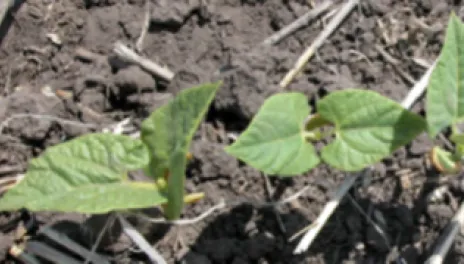NDSU seed yield summary of dry bean plant establishment factors
The following table displays a seed yield summary for two options among each of six dry bean plant establishment factors. With exceptions (tillage system and planting dates), using option A results in increased yield compared to option B, based on multiple NDSU field trials conducted during the period of 2007-22. Pinto bean was the market class included in tests among all factors, but black and navy bean were included in planting date and row spacing trials. The following is a brief overview:
- Variety selection for yield – Data from seven 2022 variety trials with pinto bean were reviewed. Varieties yielding above the trial average ranged from 1-11% greater, with an average of 6%.
- Tillage system – Yield was similar among five pinto bean trials at the Carrington REC comparing performance with strip-till versus conventional. Benefits of this reduced tillage system can be obtained without sacrifice of yield.
- Planting date – Among six site-years of trials at Carrington and Prosper, planting pinto, black and navy bean early or late did not improve yield compared to the generally normal planting period of the last 7-10 days of May through the first 7-10 days of June.
- Plant stand – Among three trials at Carrington and Langdon, pinto bean yield averaged 1650 lb per acre at 87,000 plants per acre compared to 1570 lb per acre with a stand of 72,000 plants per acre.
- Row spacing – Using reduced row spacing (14- to 22-inch) with pinto, black and navy bean, yield increased 20, 9 and 22%, respectively, compared to wide rows (28- or 30-inch). The field trials were conducted without presence of white mold (sclerotinia). The economics of field equipment replacement needs to be considered if needed for transition from wide- to intermediate-row spacing.
- Phosphorus (P) fertilizer application method – Modest rates of 10-34-0 liquid fertilizer (generally about 3 gpa) applied with the seed (in-furrow) or within two inches of the seed at planting in low-P testing soils substantially increased yield compared to a broadcast application at one-third higher rate. In-furrow applied fertilizer at greater rates than tested or with dry soil conditions may result in reduced plant stands.
|
Factor |
Option A |
A Yield > B (%) |
Option B |
NDSU trials |
|---|---|---|---|---|
|
1. Variety selection for yield |
above trial average |
6 |
trial average |
7 |
|
2. Tillage system |
strip-till |
similar |
conventional |
5 |
|
3. Planting date (pinto, black and navy) |
early (May 11-24) |
similar |
normal (May 22-June 5) |
6 |
|
late (June 5-18) |
||||
|
4. Plant stand (no./A) |
87,000 |
5 |
72,000 |
3 |
|
5a. Row spacing - pinto |
intermediate (14-22 inches) |
20 |
wide
|
11 |
|
5b. Row spacing - black |
9 |
4 |
||
|
5c. Row spacing - navy |
22 |
3 |
||
|
6. P fertilizer application |
in-furrow or band1 |
16 |
broadcast |
3 |
1 10-34-0 at 3-6 gpa (two-third of broadcast rate); band=2 inches from seed
NDSU Extension publications are available that provide research details and explanations on these dry bean plant establishment factors.
A654-22 ND Dry Bean Variety Trial Results for 2022 and Selection Guide
A113 Dry Bean Production Guide
A1921 Black and navy bean response to row spacing and plant population in eastern North Dakota
A2060 Pinto bean response to row spacing and plant population in North Dakota
AE1370 Strip till for field crop production
SF720 Fertilizing pinto, navy and other dry edible bean
A1883 Pinto bean response to phosphorus starter fertilizer in east-central ND
A1806 Impact of planting date on dry edible bean
E2088 2022 Dry bean grower survey of production, pest problems and pesticide use in MN and ND
A934 Replanting or late planting crop
Greg Endres
Gregory.Endres@ndsu.edu
Extension Cropping Systems Specialist
